테스트 절차
 변경 제안
변경 제안


이 섹션에서는 검증을 완료하는 데 필요한 작업에 대해 설명합니다.
필수 구성 요소
시나리오 1 – JupyterLab의 온디맨드 추론
-
AI/ML 추론 워크로드를 위한 Kubernetes 네임스페이스를 생성합니다.
$ kubectl create namespace inference namespace/inference created
-
NetApp DataOps 툴킷을 사용하여 추론을 수행할 데이터를 저장할 영구 볼륨을 프로비저닝합니다.
$ netapp_dataops_k8s_cli.py create volume --namespace=inference --pvc-name=inference-data --size=50Gi Creating PersistentVolumeClaim (PVC) 'inference-data' in namespace 'inference'. PersistentVolumeClaim (PVC) 'inference-data' created. Waiting for Kubernetes to bind volume to PVC. Volume successfully created and bound to PersistentVolumeClaim (PVC) 'inference-data' in namespace 'inference'.
-
NetApp DataOps Toolkit을 사용하여 새로운 JupyterLab 작업 공간을 생성합니다. '--mount-PVC' 옵션을 사용하여 이전 단계에서 생성한 영구 볼륨을 마운트합니다. 필요한 경우 '--nVidia-GPU' 옵션을 사용하여 NVIDIA GPU를 작업 공간에 할당합니다.
다음 예에서는 영구 볼륨 '추론 데이터'가 '/home/jovyan/data'의 JupyterLab 작업 영역 컨테이너에 마운트됩니다. Jupytter의 공식 컨테이너 이미지를 사용할 때 JupyterLab 웹 인터페이스 내의 최상위 디렉토리로 /home/jovyan이 표시됩니다.
$ netapp_dataops_k8s_cli.py create jupyterlab --namespace=inference --workspace-name=live-inference --size=50Gi --nvidia-gpu=2 --mount-pvc=inference-data:/home/jovyan/data Set workspace password (this password will be required in order to access the workspace): Re-enter password: Creating persistent volume for workspace... Creating PersistentVolumeClaim (PVC) 'ntap-dsutil-jupyterlab-live-inference' in namespace 'inference'. PersistentVolumeClaim (PVC) 'ntap-dsutil-jupyterlab-live-inference' created. Waiting for Kubernetes to bind volume to PVC. Volume successfully created and bound to PersistentVolumeClaim (PVC) 'ntap-dsutil-jupyterlab-live-inference' in namespace 'inference'. Creating Service 'ntap-dsutil-jupyterlab-live-inference' in namespace 'inference'. Service successfully created. Attaching Additional PVC: 'inference-data' at mount_path: '/home/jovyan/data'. Creating Deployment 'ntap-dsutil-jupyterlab-live-inference' in namespace 'inference'. Deployment 'ntap-dsutil-jupyterlab-live-inference' created. Waiting for Deployment 'ntap-dsutil-jupyterlab-live-inference' to reach Ready state. Deployment successfully created. Workspace successfully created. To access workspace, navigate to http://192.168.0.152:32721
-
'jupyterlab 생성' 명령의 출력에 지정된 URL을 사용하여 JupyterLab 작업 영역에 액세스합니다. 데이터 디렉토리는 작업 공간에 마운트된 영구 볼륨을 나타냅니다.
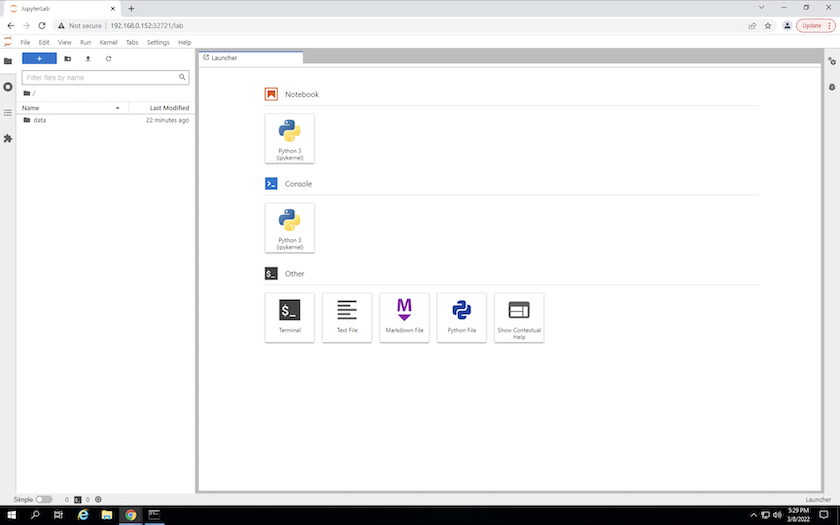
-
"ata" 디렉토리를 열고 추론을 수행할 파일을 업로드합니다. 파일이 데이터 디렉토리에 업로드되면 작업 공간에 마운트된 영구 볼륨에 자동으로 저장됩니다. 파일을 업로드하려면 다음 이미지와 같이 파일 업로드 아이콘을 클릭합니다.
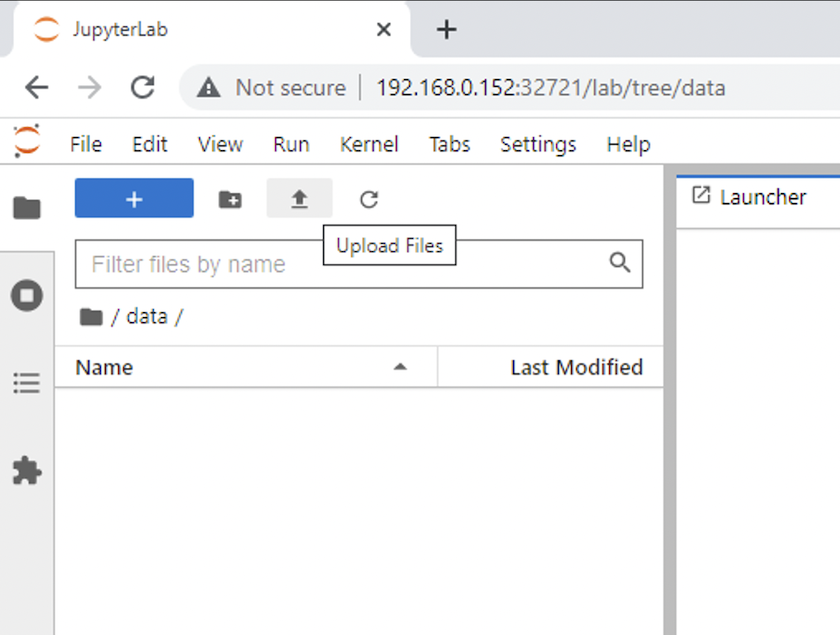
-
최상위 디렉토리로 돌아가서 새 전자 필기장을 만듭니다.
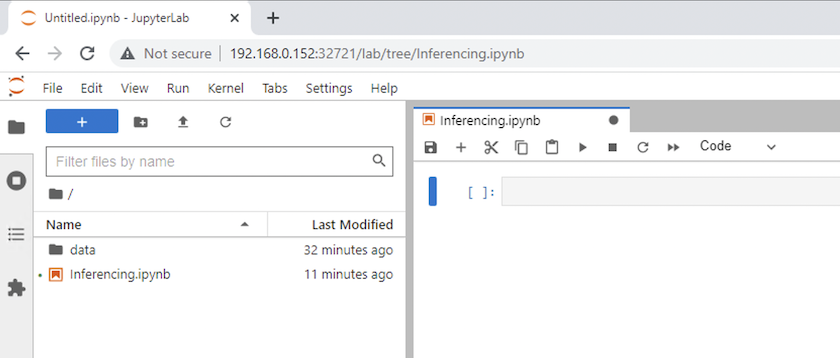
-
노트북에 추론 코드를 추가합니다. 다음 예에서는 이미지 감지 사용 사례에 대한 추론 코드를 보여 줍니다.
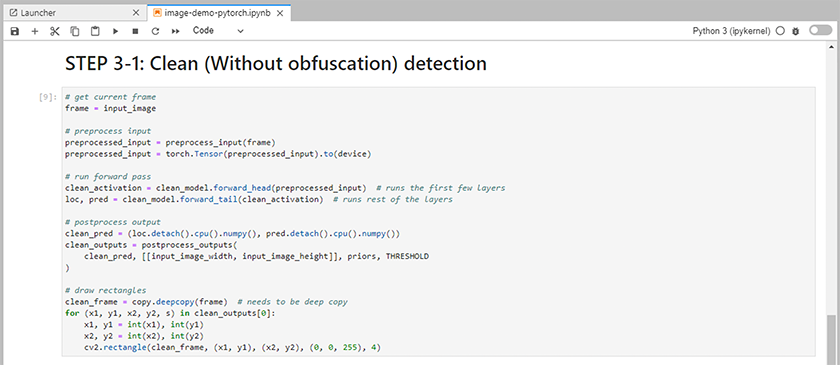
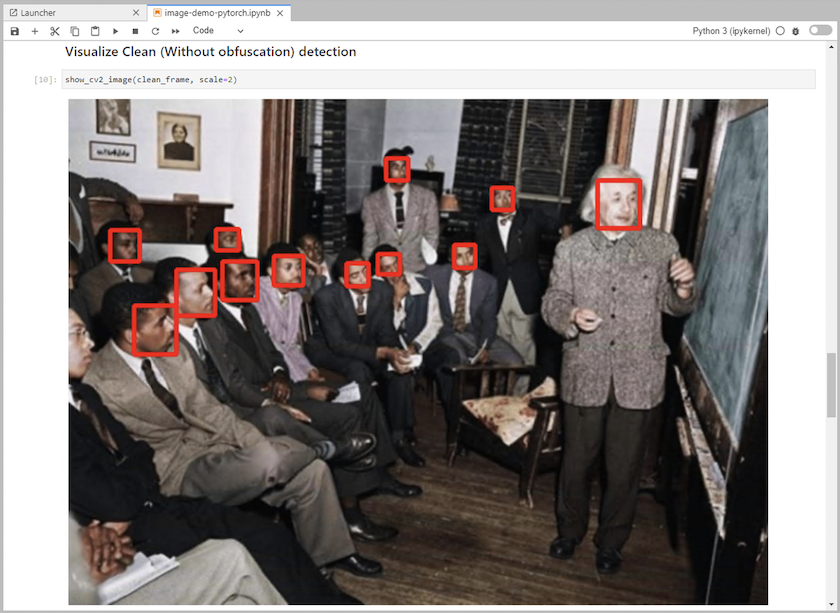
-
추론 코드에 Protopia 난독 처리를 추가합니다. Protopia는 고객과 직접 협력하여 사용 사례별 문서를 제공하며 이 기술 보고서의 범위를 벗어납니다. 다음 예제에서는 Protopia 난독 처리를 추가한 이미지 검색 사용 사례에 대한 추론 코드를 보여 줍니다.

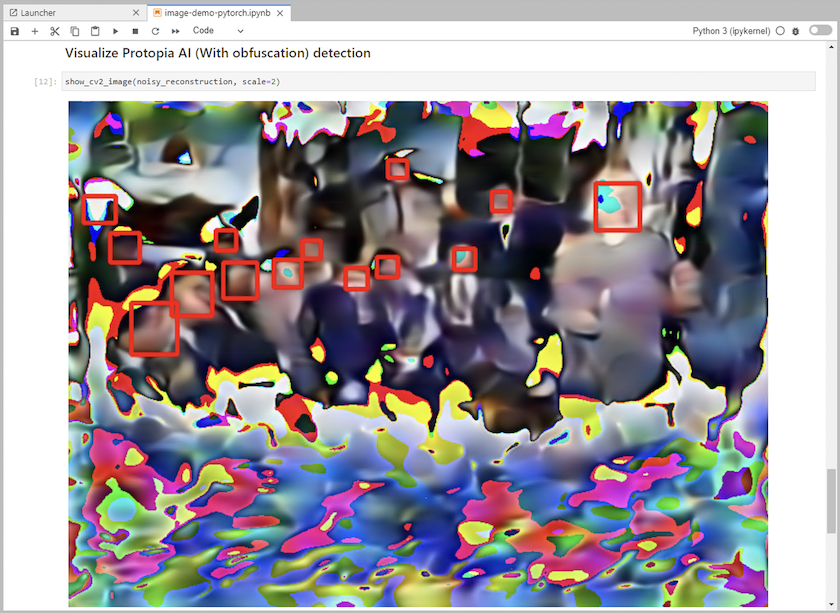
시나리오 2 – Kubernetes의 배치 추론
-
AI/ML 추론 워크로드를 위한 Kubernetes 네임스페이스를 생성합니다.
$ kubectl create namespace inference namespace/inference created
-
NetApp DataOps 툴킷을 사용하여 추론을 수행할 데이터를 저장할 영구 볼륨을 프로비저닝합니다.
$ netapp_dataops_k8s_cli.py create volume --namespace=inference --pvc-name=inference-data --size=50Gi Creating PersistentVolumeClaim (PVC) 'inference-data' in namespace 'inference'. PersistentVolumeClaim (PVC) 'inference-data' created. Waiting for Kubernetes to bind volume to PVC. Volume successfully created and bound to PersistentVolumeClaim (PVC) 'inference-data' in namespace 'inference'.
-
추론을 수행할 데이터로 새 영구 볼륨을 채웁니다.
PVC로 데이터를 로드하는 방법은 여러 가지가 있습니다. 현재 데이터가 NetApp StorageGRID 또는 Amazon S3와 같은 S3 호환 오브젝트 스토리지 플랫폼에 저장되어 있는 경우 를 사용할 수 있습니다 "NetApp DataOps 툴킷 S3 Data Mover 기능". 또 하나의 간단한 방법은 JupyterLab 작업 공간을 만든 다음, 섹션 “의 3-5단계에 설명된 대로 JupyterLab 웹 인터페이스를 통해 파일을 업로드하는 것입니다시나리오 1 – JupyterLab의 온디맨드 추론.”
-
배치 추론 작업을 위해 Kubernetes 작업을 생성합니다. 다음 예는 이미지 감지 사용 사례에 대한 배치 추론 작업을 보여줍니다. 이 작업은 이미지 세트의 각 이미지에서 추론을 수행하고 추론 정확도 메트릭을 stdout에 씁니다.
$ vi inference-job-raw.yaml apiVersion: batch/v1 kind: Job metadata: name: netapp-inference-raw namespace: inference spec: backoffLimit: 5 template: spec: volumes: - name: data persistentVolumeClaim: claimName: inference-data - name: dshm emptyDir: medium: Memory containers: - name: inference image: netapp-protopia-inference:latest imagePullPolicy: IfNotPresent command: ["python3", "run-accuracy-measurement.py", "--dataset", "/data/netapp-face-detection/FDDB"] resources: limits: nvidia.com/gpu: 2 volumeMounts: - mountPath: /data name: data - mountPath: /dev/shm name: dshm restartPolicy: Never $ kubectl create -f inference-job-raw.yaml job.batch/netapp-inference-raw created -
추론 작업이 성공적으로 완료되었는지 확인합니다.
$ kubectl -n inference logs netapp-inference-raw-255sp 100%|██████████| 89/89 [00:52<00:00, 1.68it/s] Reading Predictions : 100%|██████████| 10/10 [00:01<00:00, 6.23it/s] Predicting ... : 100%|██████████| 10/10 [00:16<00:00, 1.64s/it] ==================== Results ==================== FDDB-fold-1 Val AP: 0.9491256561145955 FDDB-fold-2 Val AP: 0.9205024466101926 FDDB-fold-3 Val AP: 0.9253013871078468 FDDB-fold-4 Val AP: 0.9399781485863011 FDDB-fold-5 Val AP: 0.9504280149478732 FDDB-fold-6 Val AP: 0.9416473519339292 FDDB-fold-7 Val AP: 0.9241631566241117 FDDB-fold-8 Val AP: 0.9072663297546659 FDDB-fold-9 Val AP: 0.9339648715035469 FDDB-fold-10 Val AP: 0.9447707905560152 FDDB Dataset Average AP: 0.9337148153739079 ================================================= mAP: 0.9337148153739079
-
추론 작업에 Protopia 난독 처리를 추가합니다. 이 기술 보고서의 범위를 벗어나는 Protopia에서 직접 Protopia 난독 처리를 추가하기 위한 사용 사례별 지침을 찾을 수 있습니다. 다음 예제는 알파 값 0.8을 사용하여 Protopia 난독 처리가 추가된 얼굴 인식 사용 사례에 대한 일괄 추론 작업을 보여 줍니다. 이 작업은 이미지 세트의 각 이미지에 대한 추론을 수행하기 전에 Protopia 난독 처리를 적용한 다음 추론 정확도 메트릭을 stdout에 기록합니다.
알파 값 0.05, 0.1, 0.2, 0.4, 0.6, 0.8, 0.9 및 0.95. 에서 결과를 볼 수 있습니다 "“추론 정확도 비교.”"
$ vi inference-job-protopia-0.8.yaml apiVersion: batch/v1 kind: Job metadata: name: netapp-inference-protopia-0.8 namespace: inference spec: backoffLimit: 5 template: spec: volumes: - name: data persistentVolumeClaim: claimName: inference-data - name: dshm emptyDir: medium: Memory containers: - name: inference image: netapp-protopia-inference:latest imagePullPolicy: IfNotPresent env: - name: ALPHA value: "0.8" command: ["python3", "run-accuracy-measurement.py", "--dataset", "/data/netapp-face-detection/FDDB", "--alpha", "$(ALPHA)", "--noisy"] resources: limits: nvidia.com/gpu: 2 volumeMounts: - mountPath: /data name: data - mountPath: /dev/shm name: dshm restartPolicy: Never $ kubectl create -f inference-job-protopia-0.8.yaml job.batch/netapp-inference-protopia-0.8 created -
추론 작업이 성공적으로 완료되었는지 확인합니다.
$ kubectl -n inference logs netapp-inference-protopia-0.8-b4dkz 100%|██████████| 89/89 [01:05<00:00, 1.37it/s] Reading Predictions : 100%|██████████| 10/10 [00:02<00:00, 3.67it/s] Predicting ... : 100%|██████████| 10/10 [00:22<00:00, 2.24s/it] ==================== Results ==================== FDDB-fold-1 Val AP: 0.8953066115834589 FDDB-fold-2 Val AP: 0.8819580264029936 FDDB-fold-3 Val AP: 0.8781107458462862 FDDB-fold-4 Val AP: 0.9085731346308461 FDDB-fold-5 Val AP: 0.9166445508275378 FDDB-fold-6 Val AP: 0.9101178994188819 FDDB-fold-7 Val AP: 0.8383443678423771 FDDB-fold-8 Val AP: 0.8476311547659464 FDDB-fold-9 Val AP: 0.8739624502111121 FDDB-fold-10 Val AP: 0.8905468076424851 FDDB Dataset Average AP: 0.8841195749171925 ================================================= mAP: 0.8841195749171925
시나리오 3 – NVIDIA Triton Inference Server
-
AI/ML 추론 워크로드를 위한 Kubernetes 네임스페이스를 생성합니다.
$ kubectl create namespace inference namespace/inference created
-
NetApp DataOps 툴킷을 사용하여 NVIDIA Triton Inference Server의 모델 저장소로 사용할 영구 볼륨을 프로비저닝합니다.
$ netapp_dataops_k8s_cli.py create volume --namespace=inference --pvc-name=triton-model-repo --size=100Gi Creating PersistentVolumeClaim (PVC) 'triton-model-repo' in namespace 'inference'. PersistentVolumeClaim (PVC) 'triton-model-repo' created. Waiting for Kubernetes to bind volume to PVC. Volume successfully created and bound to PersistentVolumeClaim (PVC) 'triton-model-repo' in namespace 'inference'.
-
의 새 영구 볼륨에 모델을 저장합니다 "형식" 이 기능은 NVIDIA Triton Inference Server에서 인식됩니다.
PVC로 데이터를 로드하는 방법은 여러 가지가 있습니다. 간단한 방법은 “의 3-5단계에 설명된 대로 JupyterLab 작업 공간을 만든 다음 JupyterLab 웹 인터페이스를 통해 파일을 업로드하는 것입니다시나리오 1 – JupyterLab의 온디맨드 추론. ”
-
NetApp DataOps 툴킷을 사용하여 새 NVIDIA Triton Inference Server 인스턴스를 구축합니다.
$ netapp_dataops_k8s_cli.py create triton-server --namespace=inference --server-name=netapp-inference --model-repo-pvc-name=triton-model-repo Creating Service 'ntap-dsutil-triton-netapp-inference' in namespace 'inference'. Service successfully created. Creating Deployment 'ntap-dsutil-triton-netapp-inference' in namespace 'inference'. Deployment 'ntap-dsutil-triton-netapp-inference' created. Waiting for Deployment 'ntap-dsutil-triton-netapp-inference' to reach Ready state. Deployment successfully created. Server successfully created. Server endpoints: http: 192.168.0.152: 31208 grpc: 192.168.0.152: 32736 metrics: 192.168.0.152: 30009/metrics
-
Triton 클라이언트 SDK를 사용하여 추론 작업을 수행합니다. 인용된 다음 Python 코드는 Triton Python 클라이언트 SDK를 사용하여 얼굴 감지 사용 사례에 대한 추론 작업을 수행합니다. 이 예에서는 Triton API를 호출하고 추론을 위해 이미지를 전달합니다. 그런 다음 Triton Inference Server가 요청을 수신하고 모델을 호출하고 추론 출력을 API 결과의 일부로 반환합니다.
# get current frame frame = input_image # preprocess input preprocessed_input = preprocess_input(frame) preprocessed_input = torch.Tensor(preprocessed_input).to(device) # run forward pass clean_activation = clean_model_head(preprocessed_input) # runs the first few layers ###################################################################################### # pass clean image to Triton Inference Server API for inferencing # ###################################################################################### triton_client = httpclient.InferenceServerClient(url="192.168.0.152:31208", verbose=False) model_name = "face_detection_base" inputs = [] outputs = [] inputs.append(httpclient.InferInput("INPUT__0", [1, 128, 32, 32], "FP32")) inputs[0].set_data_from_numpy(clean_activation.detach().cpu().numpy(), binary_data=False) outputs.append(httpclient.InferRequestedOutput("OUTPUT__0", binary_data=False)) outputs.append(httpclient.InferRequestedOutput("OUTPUT__1", binary_data=False)) results = triton_client.infer( model_name, inputs, outputs=outputs, #query_params=query_params, headers=None, request_compression_algorithm=None, response_compression_algorithm=None) #print(results.get_response()) statistics = triton_client.get_inference_statistics(model_name=model_name, headers=None) print(statistics) if len(statistics["model_stats"]) != 1: print("FAILED: Inference Statistics") sys.exit(1) loc_numpy = results.as_numpy("OUTPUT__0") pred_numpy = results.as_numpy("OUTPUT__1") ###################################################################################### # postprocess output clean_pred = (loc_numpy, pred_numpy) clean_outputs = postprocess_outputs( clean_pred, [[input_image_width, input_image_height]], priors, THRESHOLD ) # draw rectangles clean_frame = copy.deepcopy(frame) # needs to be deep copy for (x1, y1, x2, y2, s) in clean_outputs[0]: x1, y1 = int(x1), int(y1) x2, y2 = int(x2), int(y2) cv2.rectangle(clean_frame, (x1, y1), (x2, y2), (0, 0, 255), 4) -
추론 코드에 Protopia 난독 처리를 추가합니다. Protopia에서 직접 Protopia 난독 처리를 추가하기 위한 사용 사례별 지침을 찾을 수 있지만 이 프로세스는 이 기술 보고서의 범위를 벗어납니다. 다음 예제에서는 앞의 5단계에서 표시되지만 Protopia 난독 처리를 추가한 것과 동일한 Python 코드를 보여 줍니다.
이 경우, Triton API로 전달되기 전에 Protopia 난독 처리 기능이 이미지에 적용됩니다. 따라서, 난독 처리된 이미지가 로컬 시스템에서 절대 빠져나가지는 않습니다. 난독 처리된 이미지만 네트워크를 통해 전달됩니다. 이 워크플로는 신뢰할 수 있는 영역 내에서 데이터를 수집한 다음 추론을 위해 신뢰할 수 있는 영역 외부로 전달해야 하는 사용 사례에 적용됩니다. Protopia 난독 처리를 사용하지 않으면 중요한 데이터가 신뢰할 수 있는 영역을 벗어나지 않으면 이러한 유형의 워크플로를 구현할 수 없습니다.
# get current frame frame = input_image # preprocess input preprocessed_input = preprocess_input(frame) preprocessed_input = torch.Tensor(preprocessed_input).to(device) # run forward pass not_noisy_activation = noisy_model_head(preprocessed_input) # runs the first few layers ################################################################## # obfuscate image locally prior to inferencing # # SINGLE ADITIONAL LINE FOR PRIVATE INFERENCE # ################################################################## noisy_activation = noisy_model_noise(not_noisy_activation) ################################################################## ########################################################################################### # pass obfuscated image to Triton Inference Server API for inferencing # ########################################################################################### triton_client = httpclient.InferenceServerClient(url="192.168.0.152:31208", verbose=False) model_name = "face_detection_noisy" inputs = [] outputs = [] inputs.append(httpclient.InferInput("INPUT__0", [1, 128, 32, 32], "FP32")) inputs[0].set_data_from_numpy(noisy_activation.detach().cpu().numpy(), binary_data=False) outputs.append(httpclient.InferRequestedOutput("OUTPUT__0", binary_data=False)) outputs.append(httpclient.InferRequestedOutput("OUTPUT__1", binary_data=False)) results = triton_client.infer( model_name, inputs, outputs=outputs, #query_params=query_params, headers=None, request_compression_algorithm=None, response_compression_algorithm=None) #print(results.get_response()) statistics = triton_client.get_inference_statistics(model_name=model_name, headers=None) print(statistics) if len(statistics["model_stats"]) != 1: print("FAILED: Inference Statistics") sys.exit(1) loc_numpy = results.as_numpy("OUTPUT__0") pred_numpy = results.as_numpy("OUTPUT__1") ########################################################################################### # postprocess output noisy_pred = (loc_numpy, pred_numpy) noisy_outputs = postprocess_outputs( noisy_pred, [[input_image_width, input_image_height]], priors, THRESHOLD * 0.5 ) # get reconstruction of the noisy activation noisy_reconstruction = decoder_function(noisy_activation) noisy_reconstruction = noisy_reconstruction.detach().cpu().numpy()[0] noisy_reconstruction = unpreprocess_output( noisy_reconstruction, (input_image_width, input_image_height), True ).astype(np.uint8) # draw rectangles for (x1, y1, x2, y2, s) in noisy_outputs[0]: x1, y1 = int(x1), int(y1) x2, y2 = int(x2), int(y2) cv2.rectangle(noisy_reconstruction, (x1, y1), (x2, y2), (0, 0, 255), 4)



 인공 지능
인공 지능
